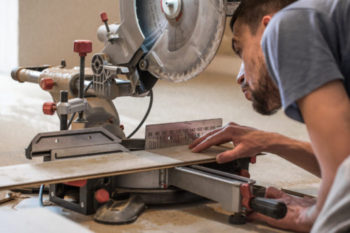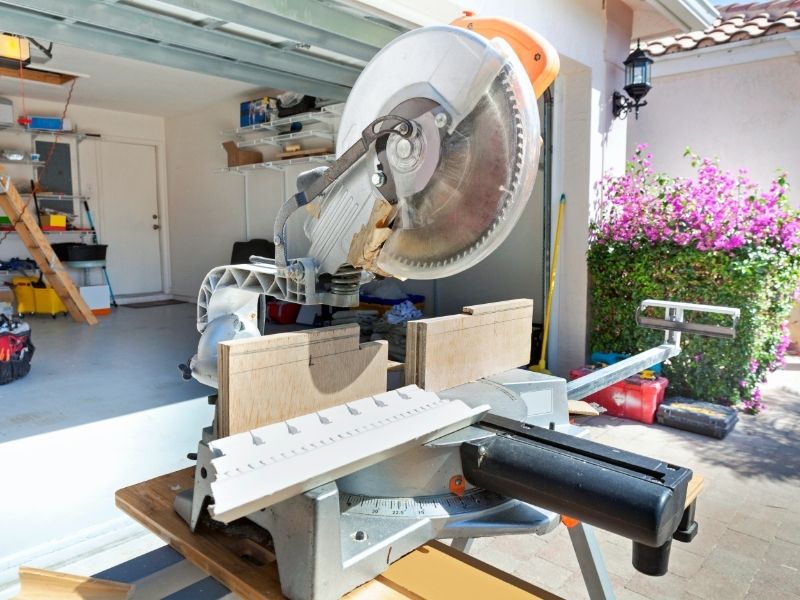
If you’re in the market for one, you may be wondering, what size miter saw do I need? To answer this question, you’ll need to know the range of sizes miter saws are available in. You may also be wondering, what to look for when buying a miter saw.
What Size Miter Saw Do I Need – 7 ¼” or as big as 20″?
Miter saws like circular saws and table saws, come in a variety of sizes. To be more specific, the blades on the saws come in different sizes. Miter saw blades can range from as small as 7 ¼” all the way up to 20” and beyond (for industrial applications). In order to determine the miter saw size for your needs, you will need to consider the types of jobs you intend to do.
Generally speaking the most popular miter saws come in two main sizes; the 10 inch and the 12 inch. Nearly all the major brands like Dewalt, Makita, Milwaukee, Bosch, and Ryobi offer 10-inch and 12-inch versions. You may be thinking, does 2 inches really make that much of a difference? Well in this instance, size does matter!
What Size Miter Saw Should I Buy? How Will Blade Size Effect the Performance?
To answer, what size miter saw should I buy, you’ll need to determine what you plan on doing with it.
For example, a miter saw with a large sized blade (12-inches and above) can make wider and deeper cuts, while a smaller sized miter saw (10-inches and below) is more economical and easy to handle. The different size in saws will allow you to tackle a wider variety of jobs and projects.
It can be confusing at first (particularly for amateurs just getting started) who are unable to tell which size saw they will need for a particular job. For example, what size miter saw should you use for crown molding? How about for laminate flooring? Can I use the same saw for both jobs?
To help you determine the right size miter saw blade for your needs, this guide will break down the uses of the various blade sizes.
10 inch Miter Saw Cut Capacity
The 10-inch miter saw cut capacity is popular with woodworkers, professionals and those into DIY. The 10-inch blade cuts pieces that are up to 6 inches wide, which covers most trim and molding boards. As trim is rarely more than 4 inches, you’ve got plenty of wiggle room with a 10-inch miter saw.
What are the benefits of a 10″ Miter Saw?
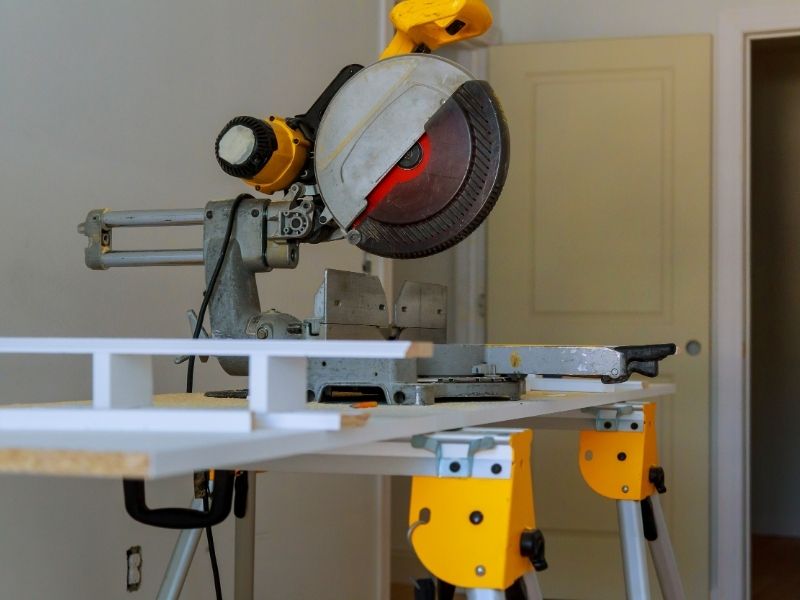
A 10-inch saw is less expensive than a 12 inch one plus the machine itself is lighter and smaller than a 12-inch version. Replacement or additional 10” blades are cheaper than their larger counterparts and often easier to find. They are pretty fast and cheaper to sharpen too.
Important to notes is that a 10-inch blade will spin faster than a 12-inch blade, which results in smoother cuts. If you have equal motors powering the two different blade sizes, the 10”will allow a higher RPM rate and the higher RPMs the finer the finish. This is very helpful when connecting trim pieces as a smoother cut will provide a snugger joint. In addition, the smaller blade will also produce less wobble and vibration generating a smoother cut.
By now you might be thinking, if a 10-inch saw is so amazing, why does anyone ever buy the 12-inch?
12-inch Miter Saw Cut Capacity
As you might have guessed, the 12 inch miter saw cut capacity makes it more expensive, heavier and generally makes less precise cuts than it’s 10 inch counterpart. However, there is an upside to this machine as it can cut wider and thicker boards than the 10 inch saving you both labor and time. If you’re working with heavy wood or large crown molding pieces, the 12 inch could be the better unit for your needs.
What are the benefits of a 12” Miter Saw?
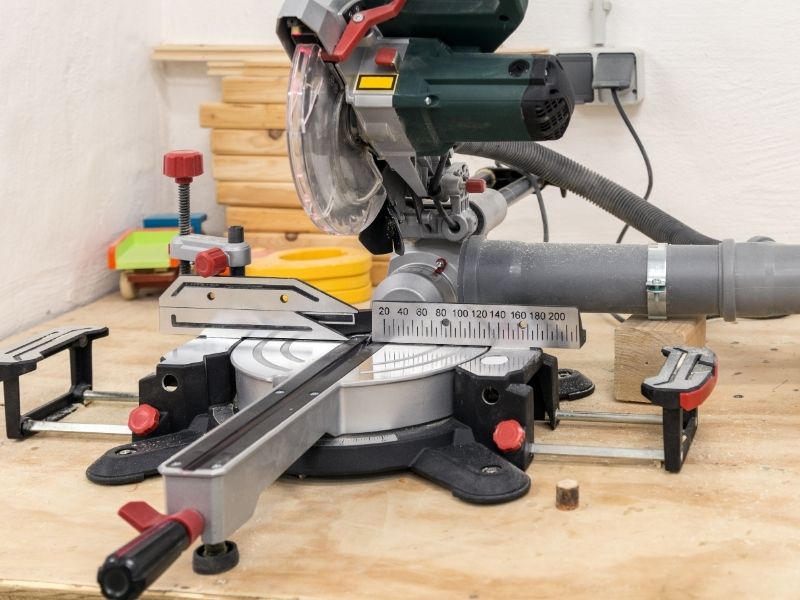
The 12 inch miter saw comes with a powerful motor allowing it to cut wider and thicker boards with less struggle. As its intentionally designed for more heavy duty cutting, the 12 inch miter saw is built to last. This provides some comfort to your investment (as they’re not cheap!)
Can you switch up the blades between the miter saws?
Admittedly you can put your 10-inch blades on your 12-inch saw (assuming the arbor holes are the same size), but you cannot put 12-inch blades on a 10-inch saw. Therefore the 12-inch saw gives you greater versatility. The larger blade is a hefty workhorse, and with the smaller blade, it’s a master of precision.
Which is better, the 10 or the 12 inch?
Due to its versatility, the 12 inch is my preferred choice. However, it is more expensive so you will need to factor that in. Really if you’ve never even considered the need for the extra capacity the 12 inch provides, then save your money and opt for the 10 inch as it’s a great saw. After all, it would be foolish to buy more tool than you need. Just buy the right tool for the right job and you won’t be disappointed.
The Best Miter Saw For The Right Job
**Disclosure: As an Amazon Associate, with no additional cost to you, I can earn from qualifying purchases. To see our full Affiliate Disclosure, please see our Terms of Service. You can also scroll to the footer of this post.
The blade size together with the job required will determine the right saw for your needs. Below are some of the most common jobs and the recommended saw size to complete them.
Miter Saw For Crown Molding
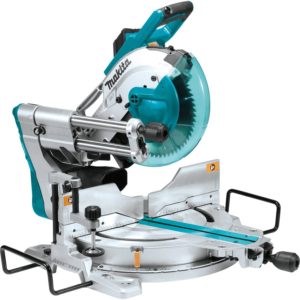
The miter saw you need for crown molding will depend on the thickness of the molding. If the molding you are cutting is around 4 to 5 inches, it would best to use a 10 inch miter saw. However if the crown molding is on the bigger side; (6 plus inches), then you should use a 12-inch miter saw. This Makita 10″ Dual Bevel Compound Sliding Miter Saw with Laser, is perfect for molding in the 4 to 5 inches sizing. Check out our more detailed review here.
If you are cutting really big crown molding (eg 9 or 10-inches), then you are going to want to opt for a 12-inch miter saw with a sliding saw blade.
The question most people have in this scenario is “can’t I just use a 10-inch, or 12-inch miter saw for all sizes of crown molding?” The answer is yes, but you will be making the job much harder for yourself. Using a bigger saw on bigger materials makes it much easier to make the sort of accurate cuts that a miter saw is meant to make.
What about sliding compound miter saws?
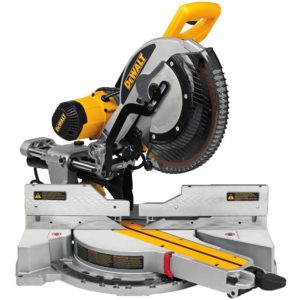
You will want to use a sliding compound miter saw on wider pieces of material as the sliding saw blade makes it so much easier to maneuver around and make accurate cuts.
What About Dual Bevel?
Dual bevel has the advantage of trimming the required angles without flipping the work-piece. It makes trimming angles so much easier.
The Right Miter Saw for Laminate Flooring
If the laminate flooring is on the larger side, then it’s best to use a 12-inch miter saw. However, if your laminate flooring is on the smaller side, then save some money and use a 10-inch miter saw instead.
One thing to note…….
You will need to factor in the actual strength of the material. Laminate flooring can be on the tougher side, so I would recommend investing in a 12-inch saw simply for the extra cutting power that it offers.
And to make the job easier…..
Opt for a sliding miter saw (as opposed to a regular one) as the sliding miter saw will easily make cuts on larger pieces of flooring. If you are professional, I would also recommend you to consider flooring saw which is specifically designed for this purpose.
What Size Miter Saw to Cut 4×4 ?
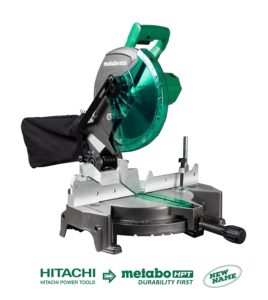
If you wonder what size miter saw to cut 4×4, then you’re in luck as there are a lot of options. You can do this with a 10 inch miter for cutting things like 4 x 4 s and other simple pieces of wood. In all honesty, you do not need anything fancy. This Metabo C10FCGS 15-Amp 10” Single Bevel Compound Miter Saw, is not too expensive, and will adequately do the job. Check out a more comprehensive review guide here, what to look for when buying a miter saw. Or to simply find out the price of this beast, click here.
Of course you can use a 12-inch miter saw on wood 4x4s, but you don’t need to buy one just for this purpose. It would be better to save the money and use a standard 10-inch miter saw.
Miter Saw or Table Saw for Baseboards?
Generally speaking, unless you are cutting very large baseboards, I would recommend sticking with a 10 or 12-inch miter saw. Both types of miter saws (10 and 12 inches) can easily and accurately cut 6-inch baseboards.
For cutting wide base boards it is best to use a sliding miter saw or you could opt for a table saw instead.
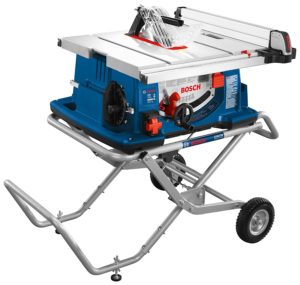
The Benefits of Table Saws
Table saws are ideal for cutting wide boards since they can accommodate large boards easily. You can just use the miter gauge to set the work-piece at the correct angle and make miter cuts on wide boards via a table saw.
One thing to note…..
Making compound angle cuts on a miter saw is a lot easier. All you have to do is rotate the table and head to the desired angle, place the work against the miter saw and do some precision cutting.
Conclusion:
The biggest takeaway is to bear in mind the size of material and job when selecting the right miter saw for your needs. Generally you can complete most miter cut jobs with a 10-inch or 12-inch miter saw. However, jobs become much easier if you use the correct sized miter saw. After all, if you’re going to get a lot of use out it, you don’t want something that is too labor intensive, too heavy to maneuver or too expensive. To check out our top 5 miter saws (in terms of value for money and their uses) click here.
